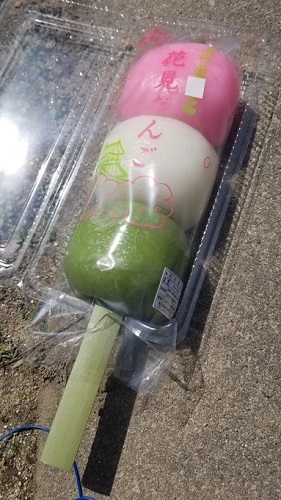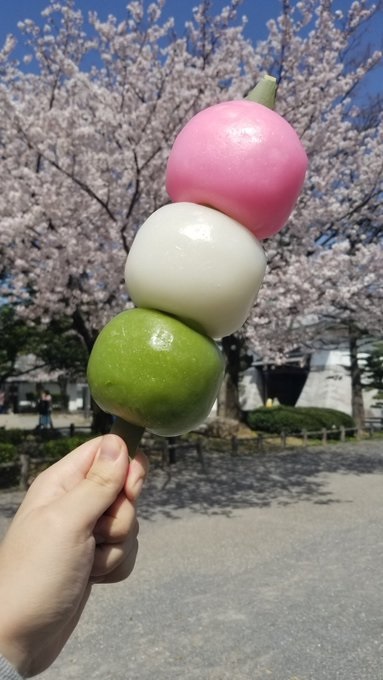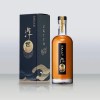
Some dango are built different, and some are built to destroy our jaws.
Made out of sticky, glutinous rice flour and one of the many dumplings existent in Japanese cuisine, dango is a popular year-round snack with different varieties depending on the season. One of the most popular types in spring is sanshoku (“three-color”) dango, a skewer of pink, white, and green dango, which is also known as hanami dango for its ubiquitous presence at hanami (cherry blossom viewing) outings.
However, for Japanese netizen @81292_II, instead of buying your typical hanami dango, they decided to go above and beyond with gigantic hanami dango, much to the joy and amazement of Japan’s Twitter-verse.
▼ “Any mention of the Okazaki Sakura Festival and I think of this. Gigantic hanami dango!!”
https://twitter.com/81292_II/status/1377113457762295809Purchased at Okazaki Park in Aichi Prefecture and consisting of humongous dango skewered on a piece of bamboo, the massive stick of hanami dango strikes onlookers with awe as well as fear. Our jaws definitely felt some sympathy pain when we tried to imagine fitting just one of those into our mouths.
▼ In a previous year, @81292_II also photographed a comparison between your typical hanami dango and the gigantic one they bought.
https://twitter.com/81292_II/status/1114071772226183168Twitter users gathered to not only share their impressions on the larger-than-life dango but also to exchange memes and jokes:
“Bring this to a swordfight and you’ll be guaranteed certain victory!”
“Can… can one person seriously finish all of that?”
“Instead of a three-color dango, it’s more like a three-meal dango.”
▼ Some folks pitched in with references: one common one was NHK’s educational cartoon Zenmai Samurai, whose protagonist wields a “Dango Blade.”
これ思い出しましたww pic.twitter.com/jg6TjBjKr7
— ぽなペン@ (@LY1G4qJeNepy7AP) March 31, 2021
For those who are curious about hanami dango’s colors, the pink dango gains its cheery hues from food coloring whereas the green dango is made from mixing mugwort with the glutinous rice flour.
One netizen also posted a lovely infographic about the symbolic meaning of hanami dango. Traditionally, the dango features the colors pink, white, and green, each representing a different aspect of spring. Pink is for the blooming sakura flowers, white denotes the end of snowfall, and green refers to the verdant summers which are to come.
▼ “Good timing as I just learned from my kid’s picture book about what the hanami dango colors mean!”
ちょうど先ほど子供の本で色にも意味があったというのを知ったばかりでした pic.twitter.com/2kZcb8vMQA
— ero23@スプ/ラ2 (@ero23nd) March 31, 2021
No matter how you enjoy hanami this year, whether it’s in a remote location with little people or at home, you can never go wrong with a stick of hanami dango, even if it can barely fit in your mouth. Just make sure to chew it thoroughly when it’s time to eat, however!
Source, images: Twitter/@81292_II
● Want to hear about SoraNews24’s latest articles as soon as they’re published? Follow us on Facebook and Twitter!

 Starbucks releases new sakura Frappuccino in Japan, but does it taste as good as it looks?
Starbucks releases new sakura Frappuccino in Japan, but does it taste as good as it looks? Starbucks Japan unveils new Sakura Frappuccino for cherry blossom-viewing season 2024
Starbucks Japan unveils new Sakura Frappuccino for cherry blossom-viewing season 2024 Starbucks has a mochi ice cream Frappuccino? New hanami dango hack goes viral in Japan
Starbucks has a mochi ice cream Frappuccino? New hanami dango hack goes viral in Japan Starbucks Japan brings sakura sweets to the table for cherry blossom season 2024
Starbucks Japan brings sakura sweets to the table for cherry blossom season 2024 Sakura tacos? The Tokyo treat we didn’t know we needed until right now
Sakura tacos? The Tokyo treat we didn’t know we needed until right now Kyoto Whopper divides customers at Burger King Japan
Kyoto Whopper divides customers at Burger King Japan Taking the Kyoto overnight bus for the first time
Taking the Kyoto overnight bus for the first time Japanese burger chain no longer serves onion rings, but offers intriguing replacement【Taste test】
Japanese burger chain no longer serves onion rings, but offers intriguing replacement【Taste test】 Berserk T-shirts coming to Uniqlo for launch of new Manga Curation line【Photos】
Berserk T-shirts coming to Uniqlo for launch of new Manga Curation line【Photos】 Children’s slippers stolen in night at Japanese preschool, police identify weasel who did it【Vid】
Children’s slippers stolen in night at Japanese preschool, police identify weasel who did it【Vid】 Starbucks Japan unveils second Holiday Frappuccino for 2024
Starbucks Japan unveils second Holiday Frappuccino for 2024 New card game makes Japan’s saunas even steamier
New card game makes Japan’s saunas even steamier The new Ranma 1/2 anime is here! So is it worth watching?【SoraReview】
The new Ranma 1/2 anime is here! So is it worth watching?【SoraReview】 Japan’s biggest manga magazine is raising its minimum payment rate for creators
Japan’s biggest manga magazine is raising its minimum payment rate for creators Sleep next to the railroad tracks at the closest hotel to a train station platform in Japan
Sleep next to the railroad tracks at the closest hotel to a train station platform in Japan One of Japan’s most beautiful hot spring towns announces new limits on number of day trippers
One of Japan’s most beautiful hot spring towns announces new limits on number of day trippers Ghibli’s Princess Mononoke teams up with Foxfire for outdoor apparel collaboration【Photos】
Ghibli’s Princess Mononoke teams up with Foxfire for outdoor apparel collaboration【Photos】 Mario Kart Happy Meal toys arrive at McDonald’s Japan, and SoraNews24 has the whole set!【Photos】
Mario Kart Happy Meal toys arrive at McDonald’s Japan, and SoraNews24 has the whole set!【Photos】 After cancelling Halloween, Tokyo’s Shibuya neighborhood cancels New Year’s Eve too
After cancelling Halloween, Tokyo’s Shibuya neighborhood cancels New Year’s Eve too Tokyo park’s sea of clouds, nighttime illumination, and cosplay days make now perfect time to visit
Tokyo park’s sea of clouds, nighttime illumination, and cosplay days make now perfect time to visit Samurai ritual suicide contest cancelled by organizer in west Japan
Samurai ritual suicide contest cancelled by organizer in west Japan Japanese job-quitting service contacted by other job-quitting service because employee wants to quit
Japanese job-quitting service contacted by other job-quitting service because employee wants to quit Flying dango: Unique tourist site where Japanese sweets are flown to you over a gorge
Flying dango: Unique tourist site where Japanese sweets are flown to you over a gorge American jackass tourist arrested after carving name into gate at Tokyo’s Meiji Shrine【Video】
American jackass tourist arrested after carving name into gate at Tokyo’s Meiji Shrine【Video】 Nintendo’s controller capsule toys are so cool, even the machine you buy them from is awesome【Pics】
Nintendo’s controller capsule toys are so cool, even the machine you buy them from is awesome【Pics】 Tokyo Disneyland loses top-attendance crown for Japanese theme parks for second year in a row
Tokyo Disneyland loses top-attendance crown for Japanese theme parks for second year in a row Ghibli Park debuts first winter illumination display with Howl’s Moving Castle theme
Ghibli Park debuts first winter illumination display with Howl’s Moving Castle theme Pringles releases a limited-edition sweet flavour in Japan
Pringles releases a limited-edition sweet flavour in Japan Sanrio and magical girl anime PreCure join forces for new merch line【Photos】
Sanrio and magical girl anime PreCure join forces for new merch line【Photos】 What’s the deal with akebi, the perfectly purple, alien-like fruit that’s in season now in Japan?
What’s the deal with akebi, the perfectly purple, alien-like fruit that’s in season now in Japan? McDonald’s new Happy Meals offer up cute and practical Sanrio lifestyle goods
McDonald’s new Happy Meals offer up cute and practical Sanrio lifestyle goods Foreign tourists on Shinkansen bullet train break suitcase etiquette, angering local passengers
Foreign tourists on Shinkansen bullet train break suitcase etiquette, angering local passengers [Deleted] Article written for April Fool’s Day 2018
[Deleted] Article written for April Fool’s Day 2018 Japanese government to make first change to romanization spelling rules since the 1950s
Japanese government to make first change to romanization spelling rules since the 1950s Foreigner’s request for help in Tokyo makes us sad for the state of society
Foreigner’s request for help in Tokyo makes us sad for the state of society Ghibli founders Toshio Suzuki and Hayao Miyazaki contribute to Japanese whisky Totoro label design
Ghibli founders Toshio Suzuki and Hayao Miyazaki contribute to Japanese whisky Totoro label design Japanese convenience store Family Mart announces abolishment of eat-in spaces
Japanese convenience store Family Mart announces abolishment of eat-in spaces Princesses, fruits, and blacksmiths: Study reveals the 30 most unusual family names in Japan
Princesses, fruits, and blacksmiths: Study reveals the 30 most unusual family names in Japan Life-size vibrating Legend of Zelda Master Sword for sale from Nintendo【Photos】
Life-size vibrating Legend of Zelda Master Sword for sale from Nintendo【Photos】 Studio Ghibli releases free-download board game — Here’s how to play it without reading Japanese
Studio Ghibli releases free-download board game — Here’s how to play it without reading Japanese Starbucks releases final sakura Frappuccino in Japan for 2024 hanami season
Starbucks releases final sakura Frappuccino in Japan for 2024 hanami season Is Starbucks Japan’s hot Hanami Sakura Cream better than the Frappuccino?
Is Starbucks Japan’s hot Hanami Sakura Cream better than the Frappuccino? Baymax mitarashi dango: The best rice dumplings you can buy or Disney-themed choking hazard?
Baymax mitarashi dango: The best rice dumplings you can buy or Disney-themed choking hazard? Watermelon Dango: Traditional Japanese dessert gets a new look for summer with an amazing flavour
Watermelon Dango: Traditional Japanese dessert gets a new look for summer with an amazing flavour Tokyo pub lets you grill traditional Japanese dessert right at your table in all-you-can-eat deal
Tokyo pub lets you grill traditional Japanese dessert right at your table in all-you-can-eat deal We became Japanese sweet chefs for a day with Popin Cooking’s DIY wagashi set
We became Japanese sweet chefs for a day with Popin Cooking’s DIY wagashi set Harvest moon brings harvest sweets in Japan, here are a few you can try!
Harvest moon brings harvest sweets in Japan, here are a few you can try! Hit anime Hana Yori Dango getting stage musical starring…maybe you?!?
Hit anime Hana Yori Dango getting stage musical starring…maybe you?!? Adorable, edible dog buttholes are part of this new take on traditional Japanese sweets
Adorable, edible dog buttholes are part of this new take on traditional Japanese sweets We try a sakura drink from a Japanese coffeehouse chain that isn’t Starbucks
We try a sakura drink from a Japanese coffeehouse chain that isn’t Starbucks This pork-wrapped Japanese dessert recipe is outside the box and out of this world【Recipe】
This pork-wrapped Japanese dessert recipe is outside the box and out of this world【Recipe】 Sakura in Japan 2019: The best spots for hanami cherry blossom viewing
Sakura in Japan 2019: The best spots for hanami cherry blossom viewing Solo cherry blossom viewing — 30 percent of young men in survey plan to see sakura alone【Survey】
Solo cherry blossom viewing — 30 percent of young men in survey plan to see sakura alone【Survey】 Starbucks Japan reveals second sakura Frappuccino for cherry blossom season 2020
Starbucks Japan reveals second sakura Frappuccino for cherry blossom season 2020 Starbucks Japan releases final Sakura Frappuccino and latte for cherry blossom season 2024
Starbucks Japan releases final Sakura Frappuccino and latte for cherry blossom season 2024
Leave a Reply